FORD EXPLORER 1997 2.G Severe Duty Supplement Manual
Manufacturer: FORD, Model Year: 1997, Model line: EXPLORER, Model: FORD EXPLORER 1997 2.GPages: 28, PDF Size: 0.36 MB
Page 11 of 28

Oil change interval
The engine oil should be changed
every three months or 5,000 km
(3,000 miles), whichever occurs
first.
If the engine oil is not changed as
recommended, inaccurate oil
readings and engine damage may
occur.
Oil filter change
Use only an approved engine oil
filter such as the Motorcraft Long
Life type or an equivalent filter
meeting Ford specification
ES-E4EE-6714AA. Install a new oil
filter at each oil change.
Fuel filter
To prolong the life of the fuel
pump and ensure dependable fuel
system performance, the fuel filter
should be changed every 96,000
km (60,000 miles). This operation
is not required, but is
recommended for California
certified vehicles.
Maintenance recommendations
11
Page 12 of 28
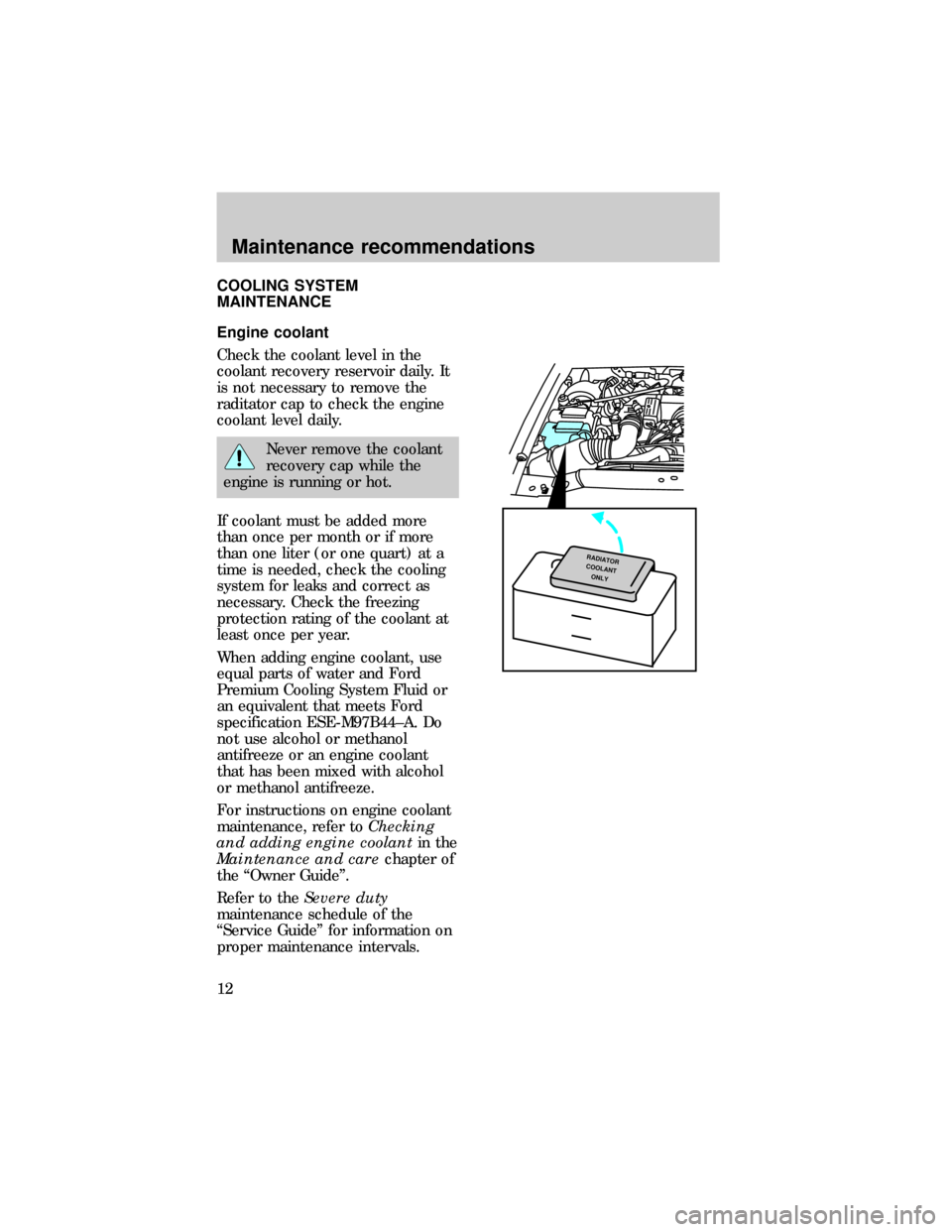
COOLING SYSTEM
MAINTENANCE
Engine coolant
Check the coolant level in the
coolant recovery reservoir daily. It
is not necessary to remove the
raditator cap to check the engine
coolant level daily.
Never remove the coolant
recovery cap while the
engine is running or hot.
If coolant must be added more
than once per month or if more
than one liter (or one quart) at a
time is needed, check the cooling
system for leaks and correct as
necessary. Check the freezing
protection rating of the coolant at
least once per year.
When adding engine coolant, use
equal parts of water and Ford
Premium Cooling System Fluid or
an equivalent that meets Ford
specification ESE-M97B44±A. Do
not use alcohol or methanol
antifreeze or an engine coolant
that has been mixed with alcohol
or methanol antifreeze.
For instructions on engine coolant
maintenance, refer toChecking
and adding engine coolantin the
Maintenance and carechapter of
the ªOwner Guideº.
Refer to theSevere duty
maintenance schedule of the
ªService Guideº for information on
proper maintenance intervals.
RADIATOR
COOLANT
ONLY
Maintenance recommendations
12
Page 13 of 28
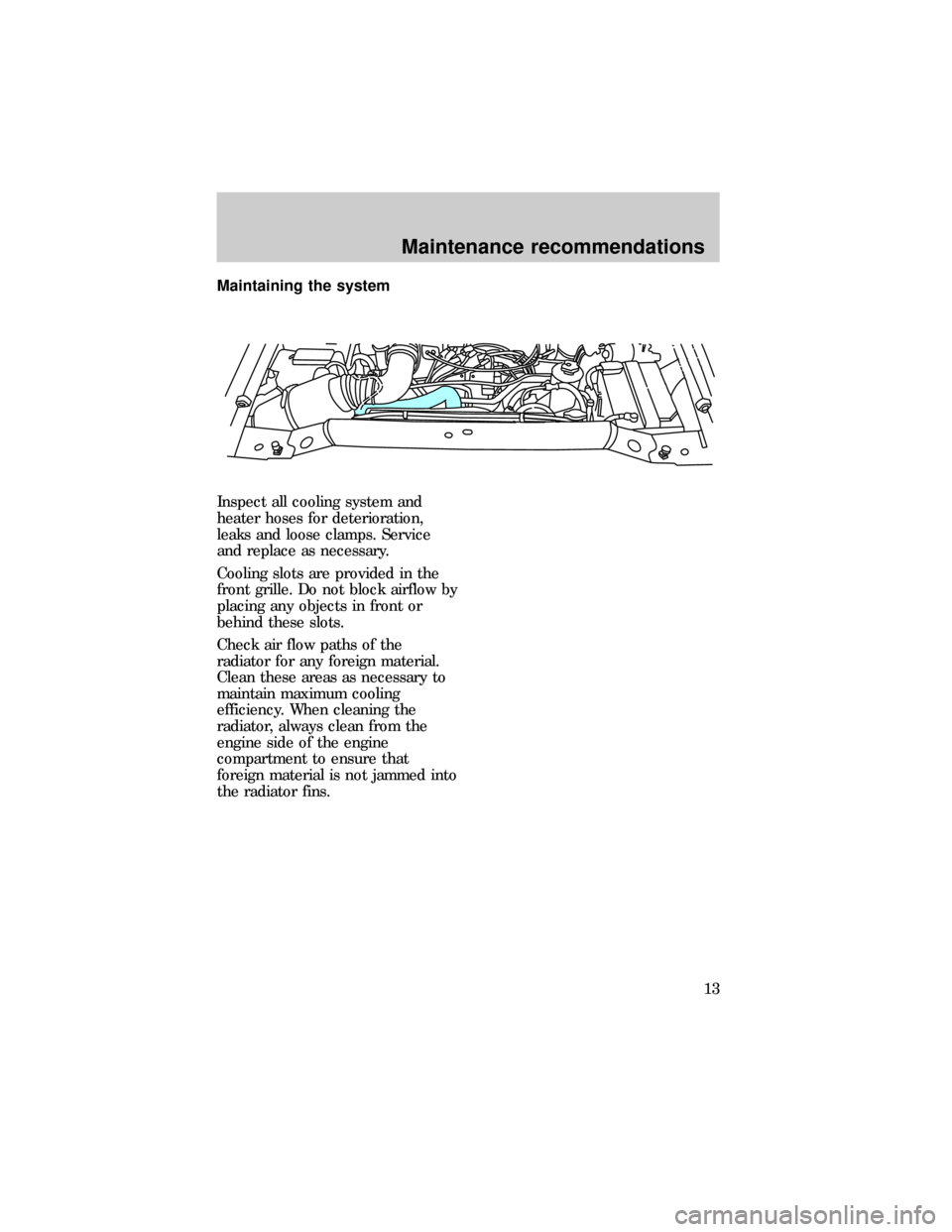
Maintaining the system
Inspect all cooling system and
heater hoses for deterioration,
leaks and loose clamps. Service
and replace as necessary.
Cooling slots are provided in the
front grille. Do not block airflow by
placing any objects in front or
behind these slots.
Check air flow paths of the
radiator for any foreign material.
Clean these areas as necessary to
maintain maximum cooling
efficiency. When cleaning the
radiator, always clean from the
engine side of the engine
compartment to ensure that
foreign material is not jammed into
the radiator fins.
Maintenance recommendations
13
Page 14 of 28
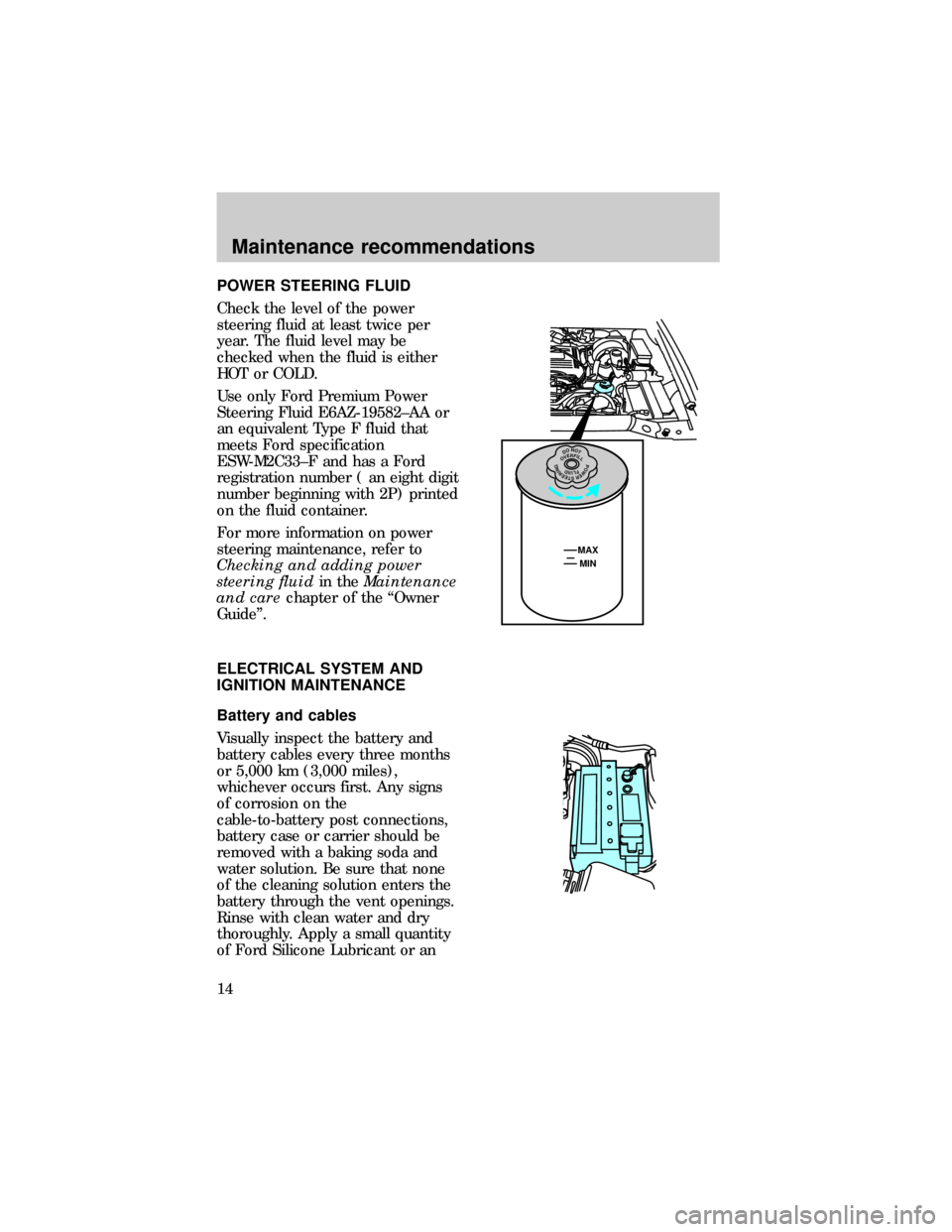
POWER STEERING FLUID
Check the level of the power
steering fluid at least twice per
year. The fluid level may be
checked when the fluid is either
HOT or COLD.
Use only Ford Premium Power
Steering Fluid E6AZ-19582±AA or
an equivalent Type F fluid that
meets Ford specification
ESW-M2C33±F and has a Ford
registration number ( an eight digit
number beginning with 2P) printed
on the fluid container.
For more information on power
steering maintenance, refer to
Checking and adding power
steering fluidin theMaintenance
and carechapter of the ªOwner
Guideº.
ELECTRICAL SYSTEM AND
IGNITION MAINTENANCE
Battery and cables
Visually inspect the battery and
battery cables every three months
or 5,000 km (3,000 miles),
whichever occurs first. Any signs
of corrosion on the
cable-to-battery post connections,
battery case or carrier should be
removed with a baking soda and
water solution. Be sure that none
of the cleaning solution enters the
battery through the vent openings.
Rinse with clean water and dry
thoroughly. Apply a small quantity
of Ford Silicone Lubricant or an
MAX
MIN
DONOTOVERFILLPOWERSTEERINGFLUID
Maintenance recommendations
14
Page 15 of 28

equivalent that meets Ford
specification ESR-M13P4±A to the
terminal surfaces to help prevent
corrosion from forming.
Check the tightness of the cables
to the battery post by hand. It may
be necessary to tighten the clamp
with a suitable wrench.
Ignition system
Visually inspect the plug wires and
ignition coil pack. Any oily dirt
should be removed and the area
cleaned with a damp cloth. Ensure
that all high voltage wires are
firmly attached to the coil pack
and that the other ends are firmly
seated over each spark plug.
Other electrical systems
Wiring, lighting and aftermarket
electrical equipment should be
checked monthly for proper
routing, deterioration or chafing on
other components.
UNDER VEHICLE
MAINTENANCE
Catalytic converters
During normal engine operation,
the catalytic converter surface
temperature can reach up to 816ÉC
(1500ÉF). To avoid injury, ensure
that the converter has cooled
before attempting maintenance.
Ford recommends that an under
vehicle inspection be performed at
Severe Dutyintervals listed in the
ªService Guideº. With the vehicle
Maintenance recommendations
15
Page 16 of 28
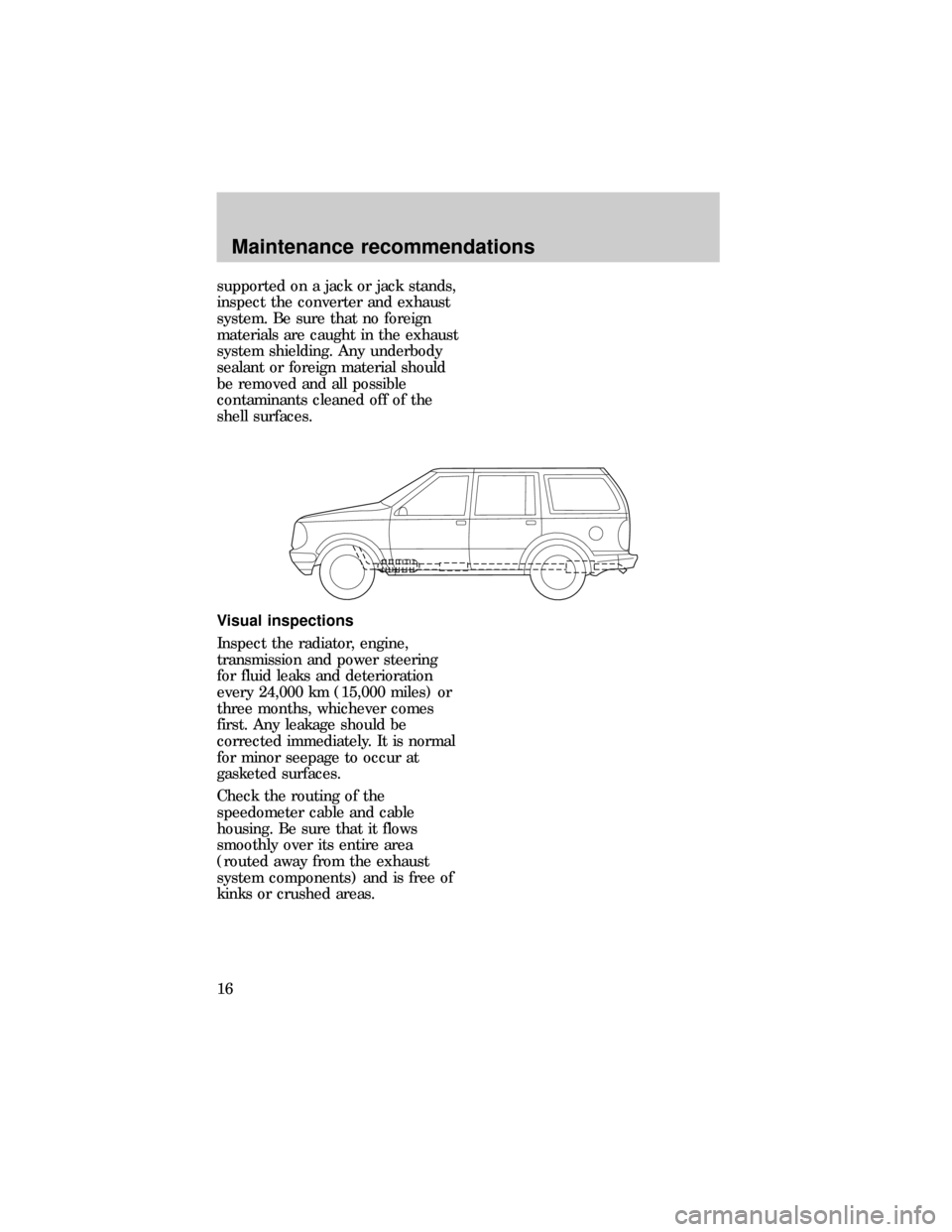
supported on a jack or jack stands,
inspect the converter and exhaust
system. Be sure that no foreign
materials are caught in the exhaust
system shielding. Any underbody
sealant or foreign material should
be removed and all possible
contaminants cleaned off of the
shell surfaces.
Visual inspections
Inspect the radiator, engine,
transmission and power steering
for fluid leaks and deterioration
every 24,000 km (15,000 miles) or
three months, whichever comes
first. Any leakage should be
corrected immediately. It is normal
for minor seepage to occur at
gasketed surfaces.
Check the routing of the
speedometer cable and cable
housing. Be sure that it flows
smoothly over its entire area
(routed away from the exhaust
system components) and is free of
kinks or crushed areas.
Maintenance recommendations
16
Page 17 of 28
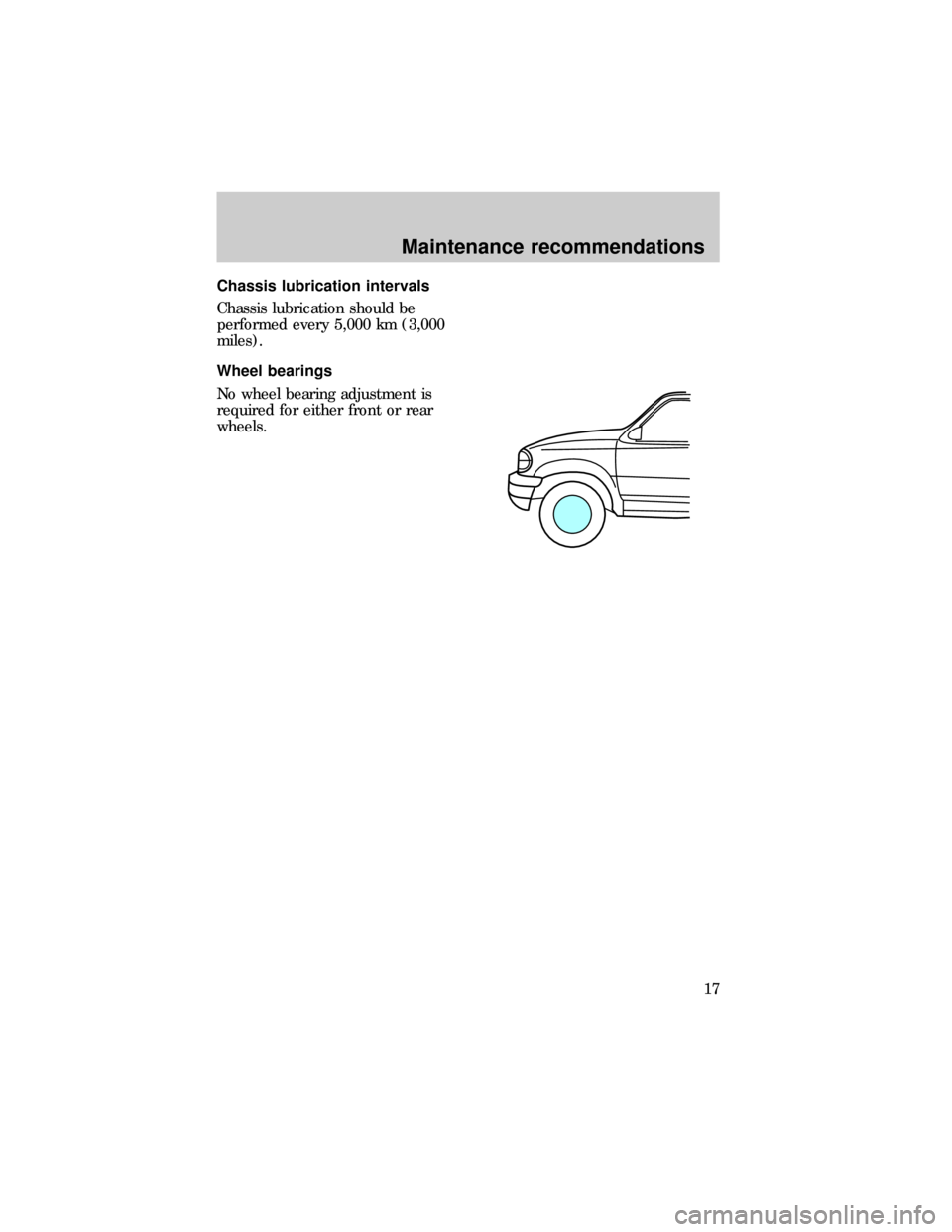
Chassis lubrication intervals
Chassis lubrication should be
performed every 5,000 km (3,000
miles).
Wheel bearings
No wheel bearing adjustment is
required for either front or rear
wheels.
Maintenance recommendations
17
Page 18 of 28
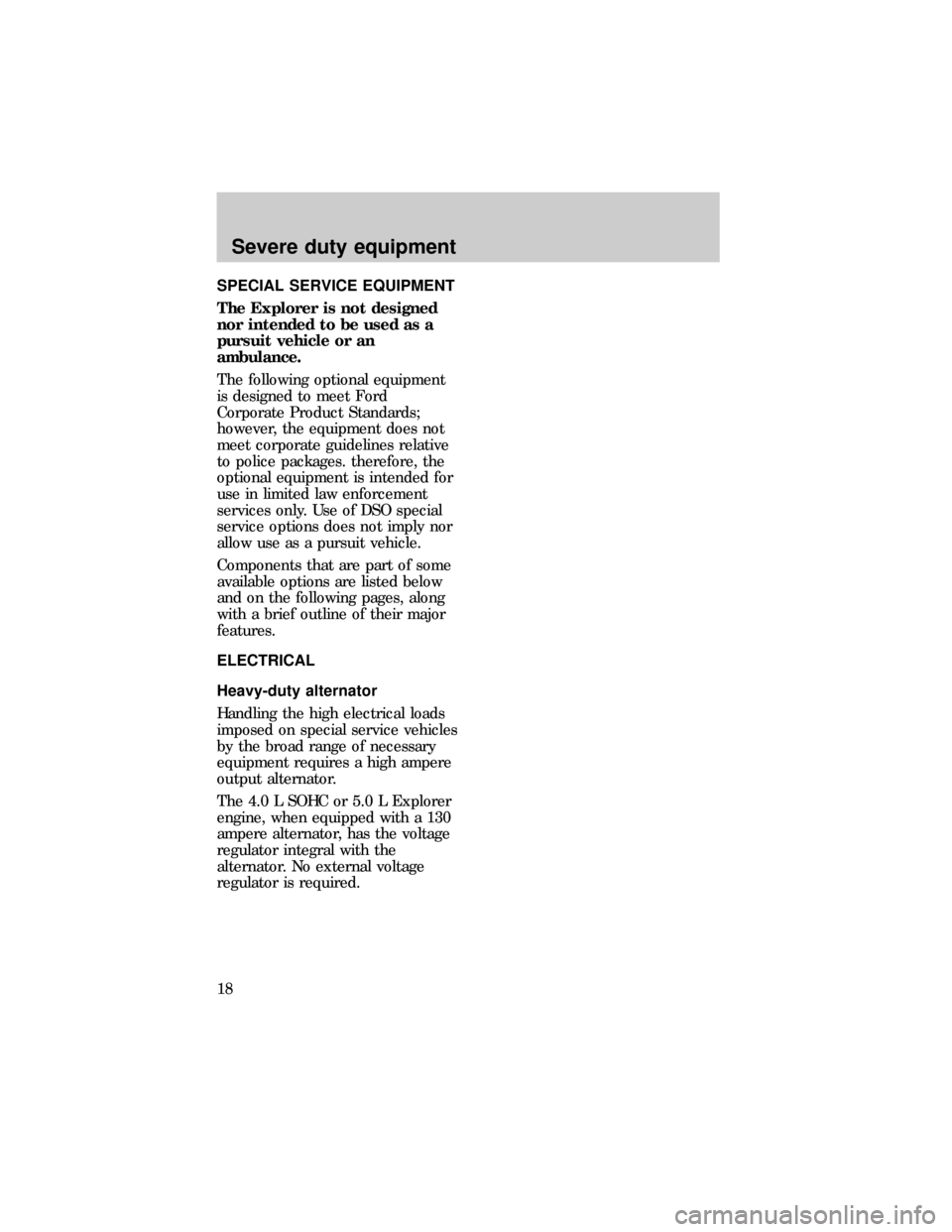
SPECIAL SERVICE EQUIPMENT
The Explorer is not designed
nor intended to be used as a
pursuit vehicle or an
ambulance.
The following optional equipment
is designed to meet Ford
Corporate Product Standards;
however, the equipment does not
meet corporate guidelines relative
to police packages. therefore, the
optional equipment is intended for
use in limited law enforcement
services only. Use of DSO special
service options does not imply nor
allow use as a pursuit vehicle.
Components that are part of some
available options are listed below
and on the following pages, along
with a brief outline of their major
features.
ELECTRICAL
Heavy-duty alternator
Handling the high electrical loads
imposed on special service vehicles
by the broad range of necessary
equipment requires a high ampere
output alternator.
The 4.0 L SOHC or 5.0 L Explorer
engine, when equipped with a 130
ampere alternator, has the voltage
regulator integral with the
alternator. No external voltage
regulator is required.
Severe duty equipment
18
Page 19 of 28
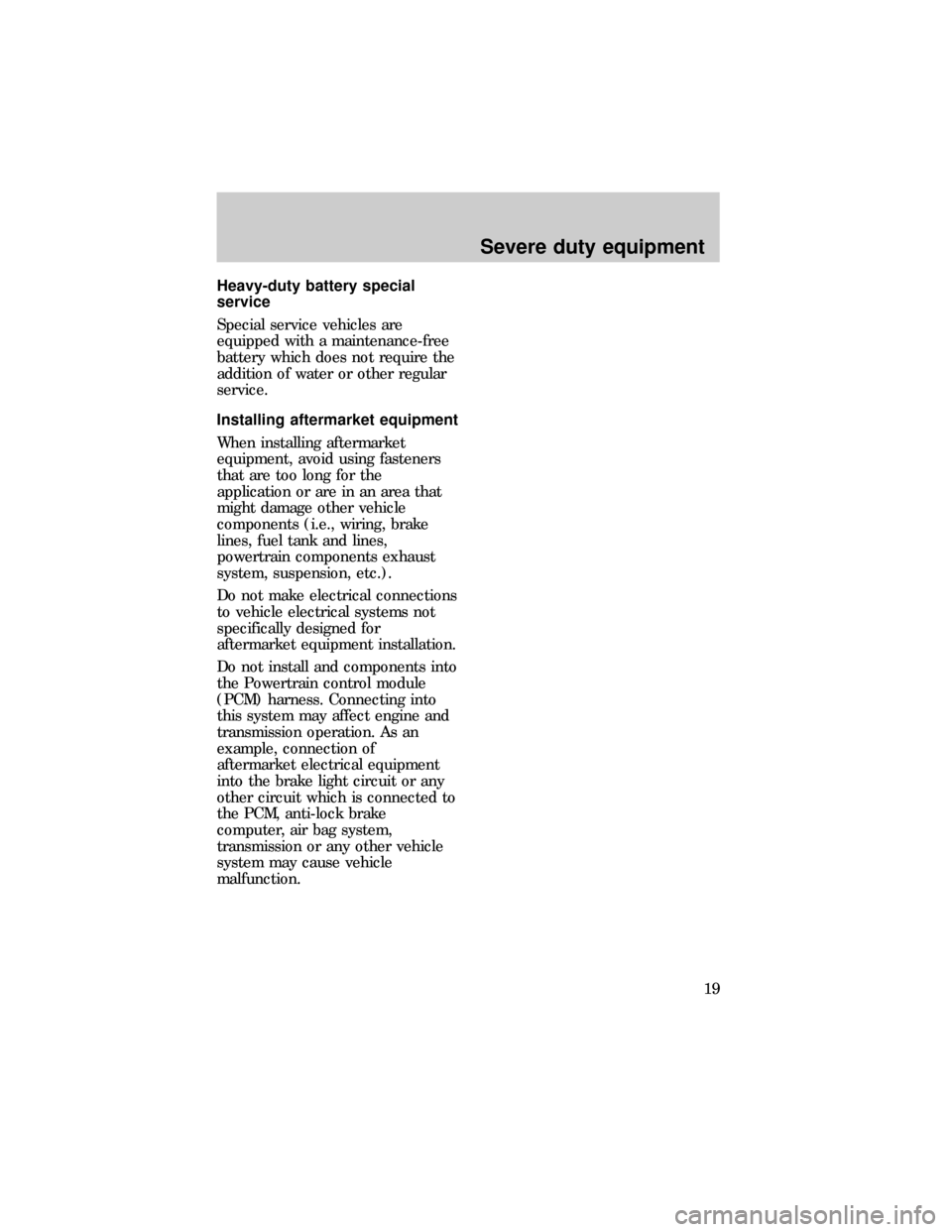
Heavy-duty battery special
service
Special service vehicles are
equipped with a maintenance-free
battery which does not require the
addition of water or other regular
service.
Installing aftermarket equipment
When installing aftermarket
equipment, avoid using fasteners
that are too long for the
application or are in an area that
might damage other vehicle
components (i.e., wiring, brake
lines, fuel tank and lines,
powertrain components exhaust
system, suspension, etc.).
Do not make electrical connections
to vehicle electrical systems not
specifically designed for
aftermarket equipment installation.
Do not install and components into
the Powertrain control module
(PCM) harness. Connecting into
this system may affect engine and
transmission operation. As an
example, connection of
aftermarket electrical equipment
into the brake light circuit or any
other circuit which is connected to
the PCM, anti-lock brake
computer, air bag system,
transmission or any other vehicle
system may cause vehicle
malfunction.
Severe duty equipment
19
Page 20 of 28
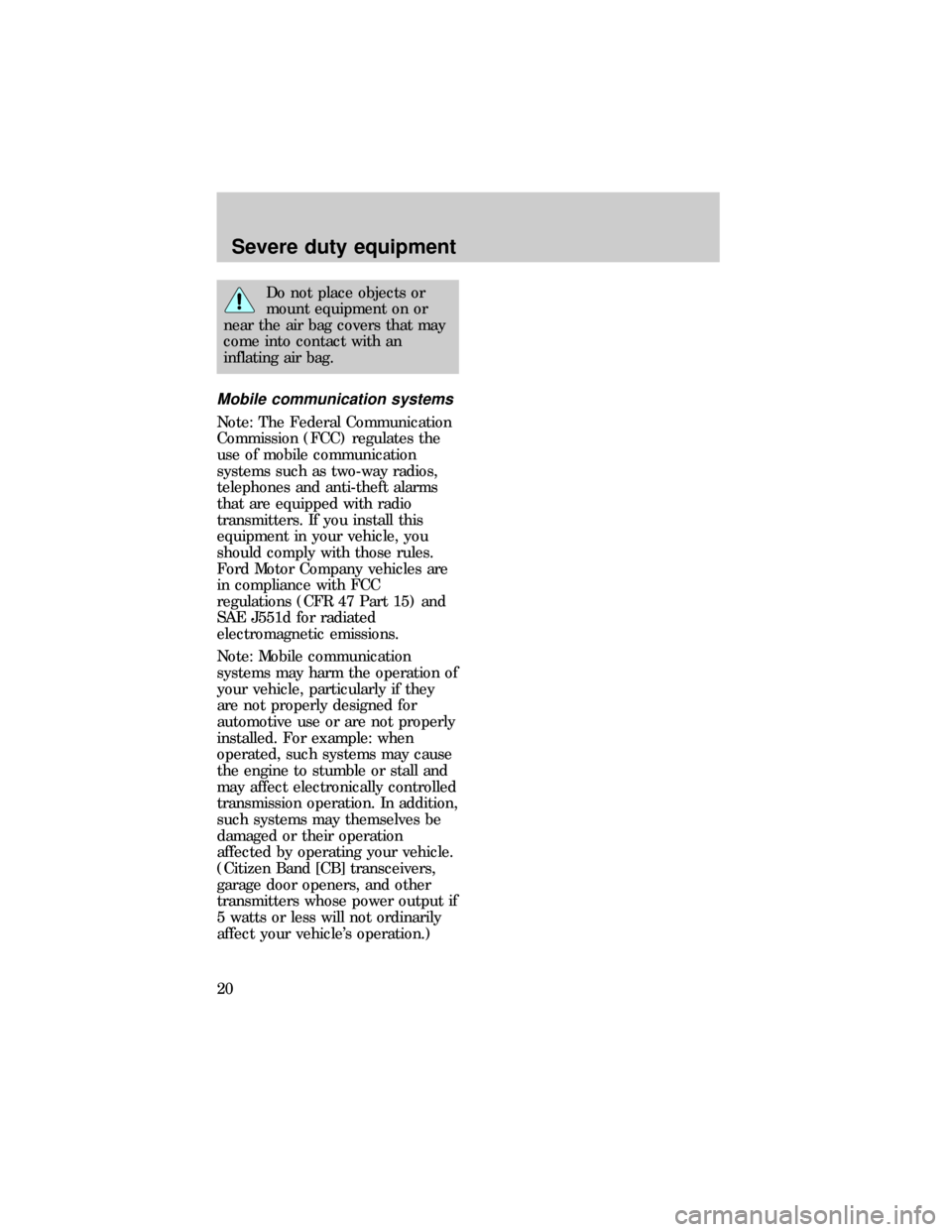
Do not place objects or
mount equipment on or
near the air bag covers that may
come into contact with an
inflating air bag.
Mobile communication systems
Note: The Federal Communication
Commission (FCC) regulates the
use of mobile communication
systems such as two-way radios,
telephones and anti-theft alarms
that are equipped with radio
transmitters. If you install this
equipment in your vehicle, you
should comply with those rules.
Ford Motor Company vehicles are
in compliance with FCC
regulations (CFR 47 Part 15) and
SAE J551d for radiated
electromagnetic emissions.
Note: Mobile communication
systems may harm the operation of
your vehicle, particularly if they
are not properly designed for
automotive use or are not properly
installed. For example: when
operated, such systems may cause
the engine to stumble or stall and
may affect electronically controlled
transmission operation. In addition,
such systems may themselves be
damaged or their operation
affected by operating your vehicle.
(Citizen Band [CB] transceivers,
garage door openers, and other
transmitters whose power output if
5 watts or less will not ordinarily
affect your vehicle's operation.)
Severe duty equipment
20